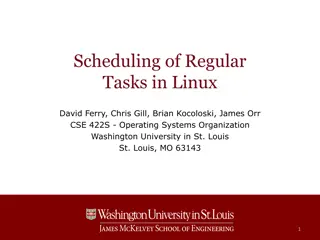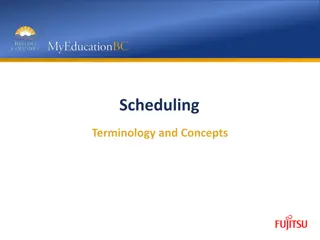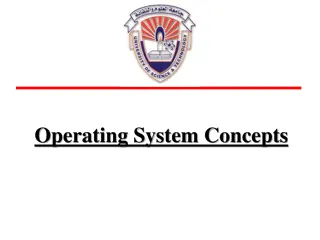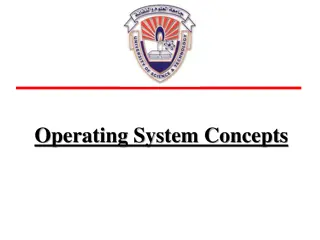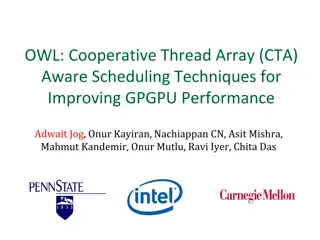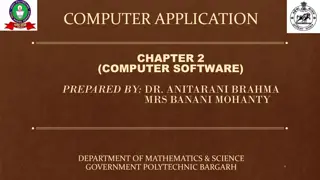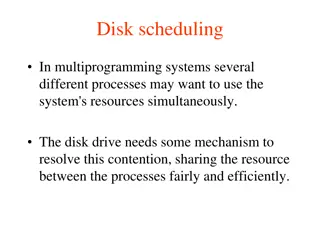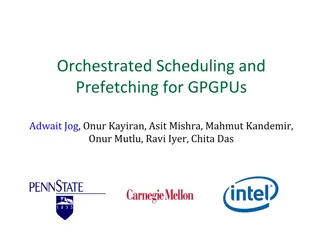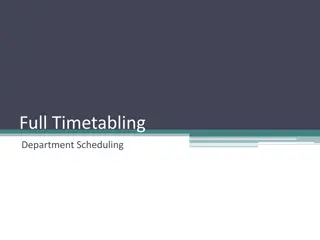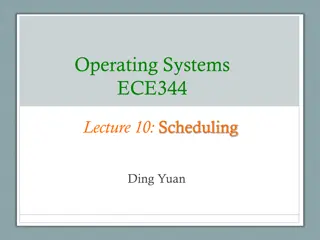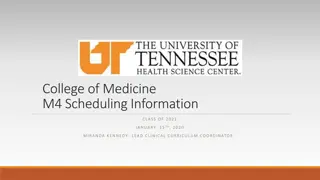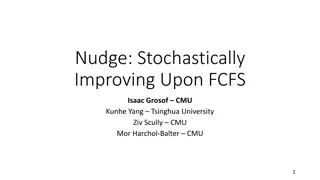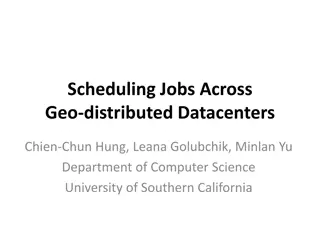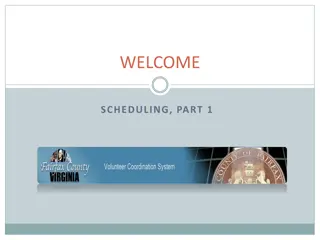Understanding Operating System Scheduling Principles
Operating system scheduling involves making decisions on resource allocation among multiple clients, determining who gets to use the resource next and for how long. Different scheduling algorithms aim to achieve specific goals, such as maximizing throughput, minimizing waiting time, ensuring fairness, and meeting priority objectives. The process queue maintains a list of processes ready to run, ordered based on the scheduling algorithm in use.
Download Presentation

Please find below an Image/Link to download the presentation.
The content on the website is provided AS IS for your information and personal use only. It may not be sold, licensed, or shared on other websites without obtaining consent from the author. Download presentation by click this link. If you encounter any issues during the download, it is possible that the publisher has removed the file from their server.
E N D
Presentation Transcript
Operating System Principles: Scheduling CS 111 Operating Systems Harry Xu Lecture 4 Page 1 CS 111 Winter 2020
Outline What is scheduling? What are our scheduling goals? What resources should we schedule? Example scheduling algorithms and their implications Lecture 4 Page 2 CS 111 Winter 2020
What Is Scheduling? An operating system often has choices about what to do next In particular: For a resource that can serve one client at a time When there are multiple potential clients Who gets to use the resource next? And for how long? Making those decisions is scheduling Lecture 4 Page 3 CS 111 Winter 2020
OS Scheduling Examples What job to run next on an idle core? How long should we let it run? In what order to handle a set of block requests for a disk drive? If multiple messages are to be sent over the network, in what order should they be sent? We ll primarily consider scheduling processes Lecture 4 Page 4 CS 111 Winter 2020
How Do We Decide How To Schedule? Generally, we choose goals we wish to achieve And design a scheduling algorithm that is likely to achieve those goals Different scheduling algorithms try to optimize different quantities So changing our scheduling algorithm can drastically change system behavior Lecture 4 Page 5 CS 111 Winter 2020
The Process Queue The OS typically keeps a queue of processes that are ready to run Ordered by whichever one should run next Which depends on the scheduling algorithm used When time comes to schedule a new process, grab the first one on the process queue Processes that are not ready to run either: Aren t in that queue Or are at the end Lecture 4 Page 6 CS 111 Winter 2020
Potential Scheduling Goals Maximize throughput Get as much work done as possible Minimize average waiting time Try to avoid delaying too many for too long Ensure some degree of fairness E.g., minimize worst case waiting time Meet explicit priority goals Scheduled items tagged with a relative priority Real time scheduling Scheduled items tagged with a deadline to be met Lecture 4 Page 7 CS 111 Winter 2020
Different Kinds of Systems, Different Scheduling Goals Time sharing Fast response time to interactive programs Each user gets an equal share of the CPU Batch Maximize total system throughput Delays of individual processes are unimportant Real-time Critical operations must happen on time Non-critical operations may not happen at all Lecture 4 Page 8 CS 111 Winter 2020
Preemptive Vs. Non-Preemptive Scheduling When we schedule a piece of work, we could let it use the resource until it finishes Or we could interrupt it part way through Allowing other pieces of work to run instead If scheduled work always runs to completion, the scheduler is non-preemptive If the scheduler temporarily halts running work to run something else, it s preemptive Lecture 4 Page 9 CS 111 Winter 2020
Pros and Cons of Non-Preemptive Scheduling +Low scheduling overhead +Tends to produce high throughput +Conceptually very simple Poor response time for processes Bugs can cause machine to freeze up If process contains infinite loop, e.g. Not good fairness (by most definitions) May make real time and priority scheduling difficult Lecture 4 Page 10 CS 111 Winter 2020
Pros and Cons of Pre-emptive Scheduling +Can give good response time +Can produce very fair usage +Good for real-time and priority scheduling More complex Requires ability to cleanly halt process and save its state May not get good throughput Possibly higher overhead Lecture 4 Page 11 CS 111 Winter 2020
Scheduling: Policy and Mechanism The scheduler will move jobs into and out of a processor (dispatching) Requiring various mechanics to do so Part of the scheduling mechanism How dispatching is done should not depend on the policy used to decide who to dispatch Desirable to separate the choice of who runs (policy) from the dispatching mechanism Also desirable that OS process queue structure not be policy-dependent Lecture 4 Page 12 CS 111 Winter 2020
Scheduling the CPU yield (or preemption) context switcher ready queue CPU dispatcher resource manager resource granted resource request new process Lecture 4 Page 13 CS 111 Winter 2020
Scheduling and Performance How you schedule important system activities has a major effect on performance Performance has different aspects You may not be able to optimize for all of them Scheduling performance has very different characteristic under light vs. heavy load Important to understand the performance basics regarding scheduling Lecture 4 Page 14 CS 111 Winter 2020
General Comments on Performance Performance goals should be quantitative and measurable If we want goodness we must be able to quantify it You cannot optimize what you do not measure Metrics ... the way & units in which we measure Choose a characteristic to be measured It must correlate well with goodness/badness of service Find a unit to quantify that characteristic It must a unit that can actually be measured Define a process for measuring the characteristic That s enough for now But actually measuring performance is complex Lecture 4 Page 15 CS 111 Winter 2020
How Should We Quantify Scheduler Performance? Candidate metric: throughput (processes/second) But different processes need different run times Process completion time not controlled by scheduler Candidate metric: delay (milliseconds) But specifically what delays should we measure? Time to finish a job (turnaround time)? Time to get some response? Some delays are not the scheduler's fault Time to complete a service request Time to wait for a busy resource Lecture 4 Page 16 CS 111 Winter 2020
Other Scheduling Metrics Mean time to completion (seconds) For a particular job mix (benchmark) Throughput (operations per second) For a particular activity or job mix (benchmark) Mean response time (milliseconds) Time spent on the ready queue Overall goodness Requires a customer specific weighting function Often stated in Service Level Agreements (SLAs) Lecture 4 Page 17 CS 111 Winter 2020
An Example Measuring CPU Scheduling Process execution can be divided into phases Time spent running The process controls how long it needs to run Time spent waiting for resources or completions Resource managers control how long these take Time spent waiting to be run This time is controlled by the scheduler Proposed metric: Time that ready processes spend waiting for the CPU Lecture 4 Page 18 CS 111 Winter 2020
Typical Throughput vs. Load Curve Maximum possible capacity ideal throughput typical offered load Lecture 4 Page 19 CS 111 Winter 2020
Why Dont We Achieve Ideal Throughput? Scheduling is not free It takes time to dispatch a process (overhead) More dispatches mean more overhead (lost time) Less time (per second) is available to run processes How to minimize the performance gap Reduce the overhead per dispatch Minimize the number of dispatches (per second) This phenomenon is seen in many areas besides process scheduling Lecture 4 Page 20 CS 111 Winter 2020
Typical Response Time vs. Load Curve typical Delay (response time) ideal offered load Lecture 4 Page 21 CS 111 Winter 2020
Why Does Response Time Explode? Real systems have finite limits Such as queue size When limits exceeded, requests are typically dropped Which is an infinite response time, for them There may be automatic retries (e.g., TCP), but they could be dropped, too If load arrives a lot faster than it is serviced, lots of stuff gets dropped Unless you re careful, overheads explode during periods of heavy load Lecture 4 Page 22 CS 111 Winter 2020
Graceful Degradation When is a system overloaded ? When it is no longer able to meet its service goals What can we do when overloaded? Continue service, but with degraded performance Maintain performance by rejecting work Resume normal service when load drops to normal What should we not do when overloaded? Allow throughput to drop to zero (i.e., stop doing work) Allow response time to grow without limit Lecture 4 Page 23 CS 111 Winter 2020
Non-Preemptive Scheduling Scheduled process runs until it yields CPU Works well for simple systems Small numbers of processes With natural producer consumer relationships Good for maximizing throughput Depends on each process to voluntarily yield A piggy process can starve others A buggy process can lock up the entire system Lecture 4 Page 24 CS 111 Winter 2020
Non-Preemptive Scheduling Algorithms First come first served Shortest job next We won t cover this in detail Real time schedulers Lecture 4 Page 25 CS 111 Winter 2020
First Come First Served The simplest of all scheduling algorithms Run first process on ready queue Until it completes or yields Then run next process on queue Until it completes or yields Highly variable delays Depends on process implementations All processes will eventually be served Lecture 4 Page 26 CS 111 Winter 2020
First Come First Served Example Dispatch Order 0, 1, 2, 3, 4 Process 0 1 2 3 4 Total Duration 350 125 475 250 75 1275 Start Time 0 350 475 950 1200 End Time 350 475 950 1200 1275 Average wait 595 595 Note: Average is worse than total/5 because four other processes had to wait for the slow-poke who ran first. Lecture 4 Page 27 CS 111 Winter 2020
When Would First Come First Served Work Well? FCFS scheduling is very simple It may deliver very poor response time Thus it makes the most sense: 1. When response time is not important (e.g., batch) 2. In embedded (e.g., telephone or set-top box) systems Where computations are brief And/or exist in natural producer/consumer relationships Lecture 4 Page 28 CS 111 Winter 2020
Real Time Schedulers For certain systems, some things must happen at particular times E.g., industrial control systems If you don t rivet the widget before the conveyer belt moves, you have a worthless widget These systems must schedule on the basis of real-time deadlines Can be either hard or soft Lecture 4 Page 29 CS 111 Winter 2020
Hard Real Time Schedulers The system absolutely must meet its deadlines By definition, system fails if a deadline is not met E.g., controlling a nuclear power plant . . . How can we ensure no missed deadlines? Typically by very, very careful analysis Make sure no possible schedule causes a deadline to be missed By working it out ahead of time Then scheduler rigorously follows deadlines Lecture 4 Page 30 CS 111 Winter 2020
Ensuring Hard Deadlines Must have deep understanding of the code used in each job You know exactly how long it will take Vital to avoid non-deterministic timings Even if the non-deterministic mechanism usually speeds things up You re screwed if it ever slows them down Typically means you do things like turn off interrupts And scheduler is non-preemptive Typically you set up a pre-defined schedule No run time decisions Lecture 4 Page 31 CS 111 Winter 2020
Soft Real Time Schedulers Highly desirable to meet your deadlines But some (or any) of them can occasionally be missed Goal of scheduler is to avoid missing deadlines With the understanding that you miss a few May have different classes of deadlines Some harder than others Need not require quite as much analysis Lecture 4 Page 32 CS 111 Winter 2020
What If You Dont Meet a Deadline? Depends on the particular type of system Might just drop the job whose deadline you missed Might allow system to fall behind Might drop some other job in the future At any rate, it will be well defined in each particular system Lecture 4 Page 33 CS 111 Winter 2020
What Algorithms Do You Use For Soft Real Time? Most common is Earliest Deadline First Each job has a deadline associated with it Based on a common clock Keep the job queue sorted by those deadlines Whenever one job completes, pick the first one off the queue Prune the queue to remove missed deadlines Goal: Minimize total lateness Lecture 4 Page 34 CS 111 Winter 2020
Example of a Soft Real Time Scheduler A video playing device Frames arrive From disk or network or wherever Ideally, each frame should be rendered on time To achieve highest user-perceived quality If you can t render a frame on time, might be better to skip it entirely Rather than fall further behind Lecture 4 Page 35 CS 111 Winter 2020
Preemptive Scheduling Again in the context of CPU scheduling A thread or process is chosen to run It runs until either it yields Or the OS decides to interrupt it At which point some other process/thread runs Typically, the interrupted process/thread is restarted later Lecture 4 Page 36 CS 111 Winter 2020
Implications of Forcing Preemption A process can be forced to yield at any time If a more important process becomes ready Perhaps as a result of an I/O completion interrupt If running process s importance is lowered Perhaps as a result of having run for too long Interrupted process might not be in a clean state Which could complicate saving and restoring its state Enables enforced fair share scheduling Introduces extra context switches Not required by the dynamics of processes Creates potential resource sharing problems Lecture 4 Page 37 CS 111 Winter 2020
Implementing Preemption Need a way to get control away from process E.g., process makes a sys call, or clock interrupt Consult scheduler before returning to process Has any ready process had its priority raised? Has any process been awakened? Has current process had its priority lowered? Scheduler finds highest priority ready process If current process, return as usual If not, yield on behalf of current process and switch to higher priority process Lecture 4 Page 38 CS 111 Winter 2020
Clock Interrupts Modern processors contain a clock A peripheral device With limited powers Can generate an interrupt at a fixed time interval Which temporarily halts any running process Good way to ensure that runaway process doesn t keep control forever Key technology for preemptive scheduling Lecture 4 Page 39 CS 111 Winter 2020
Round Robin Scheduling Algorithm Goal - fair share scheduling All processes offered equal shares of CPU All processes experience similar queue delays All processes are assigned a nominal time slice Usually the same sized slice for all Each process is scheduled in turn Runs until it blocks, or its time slice expires Then put at the end of the process queue Then the next process is run Eventually, each process reaches front of queue Lecture 4 Page 40 CS 111 Winter 2020
Properties of Round Robin Scheduling All processes get relatively quick chance to do some computation At the cost of not finishing any process as quickly A big win for interactive processes Far more context switches Which can be expensive Lecture 4 Page 41 CS 111 Winter 2020
Round Robin and I/O Interrupts Processes get halted by round robin scheduling if their time slice expires If they block for I/O (or anything else) on their own, the scheduler doesn t halt them Thus, some percentage of the time in round robin acts no differently than FIFO When I/O occurs in a process and it blocks Lecture 4 Page 42 CS 111 Winter 2020
Round Robin Example Assume a 50 msec time slice Length Process 1st Finish 2nd 3d 4th 5th 6th 7th 8th Switches 0 0 350 7 1100 0 250 475 650 800 950 1050 1 1 125 3 550 50 300 525 2 2 475 10 1275 1150 1200 1250 350 550 700 850 1000 1100 100 3 3 250 5 900 400 600 750 900 150 4 4 75 2 475 1275 200 450 27 Average waiting time: 100 msec First process completed: 475 msec Lecture 4 Page 43 CS 111 Winter 2020
Comparing Round Robin to FIFO Context switches: 27 vs. 5 for FIFO Clearly more expensive First job completed: 475 msec vs. 350 for FIFO Can take longer to complete first process Average waiting time: 100 msec vs. 595 for FIFO For first opportunity to compute Clearly more responsive Lecture 4 Page 44 CS 111 Winter 2020
Choosing a Time Slice Performance of a preemptive scheduler depends heavily on how long the time slice is Long time slices avoid too many context switches Which waste cycles So better throughput and utilization Short time slices provide better response time to processes How to balance? Lecture 4 Page 45 CS 111 Winter 2020
Costs of a Context Switch Entering the OS Taking interrupt, saving registers, calling scheduler Cycles to choose who to run The scheduler/dispatcher does work to choose Moving OS context to the new process Switch stack, non-resident process description Switching process address spaces Map-out old process, map-in new process Losing instruction and data caches Greatly slowing down the next hundred instructions Lecture 4 Page 46 CS 111 Winter 2020
Multi-Level Feedback Queue (MLFQ) Scheduling One time slice length may not fit all processes Create multiple ready queues Short time (foreground) tasks that finish quickly Short but frequent time slices, optimize response time Long time (background) tasks that run longer Longer but infrequent time slices, minimize overhead Different queues may get different shares of the CPU Finds balance between good response time and good turnaround time Lecture 4 Page 47 CS 111 Winter 2020
How Do I Know What Queue To Put New Process Into? If it s in the wrong queue, its scheduling discipline causes it problems Start all processes in short time queue Move to longer queue if too many time-slice ends Move back to shorter queue if too few time slice ends Processes dynamically find the right queue If you also have real time tasks, you know where they belong Start them in real time queue and don t move them Lecture 4 Page 48 CS 111 Winter 2020
Multiple Queue Scheduling 20% real time queue tsmax= 50% short time queue tsmax = 500us share scheduler 25% medium time queue tsmax = 2ms 05% long time queue tsmax = 5ms Lecture 4 Page 49 CS 111 Winter 2020
What Benefits Do We Expect From MLFQ? Acceptable response time for interactive jobs Or other jobs with regular external inputs It won t be too long before they re scheduled But they won t waste CPU running for a long time Efficient but fair CPU use for non-interactive jobs They run for a long time slice without interruption Predictable real time response Based on known percentage of CPU Dynamic and automatic adjustment of scheduling based on actual behavior of jobs Lecture 4 Page 50 CS 111 Winter 2020


